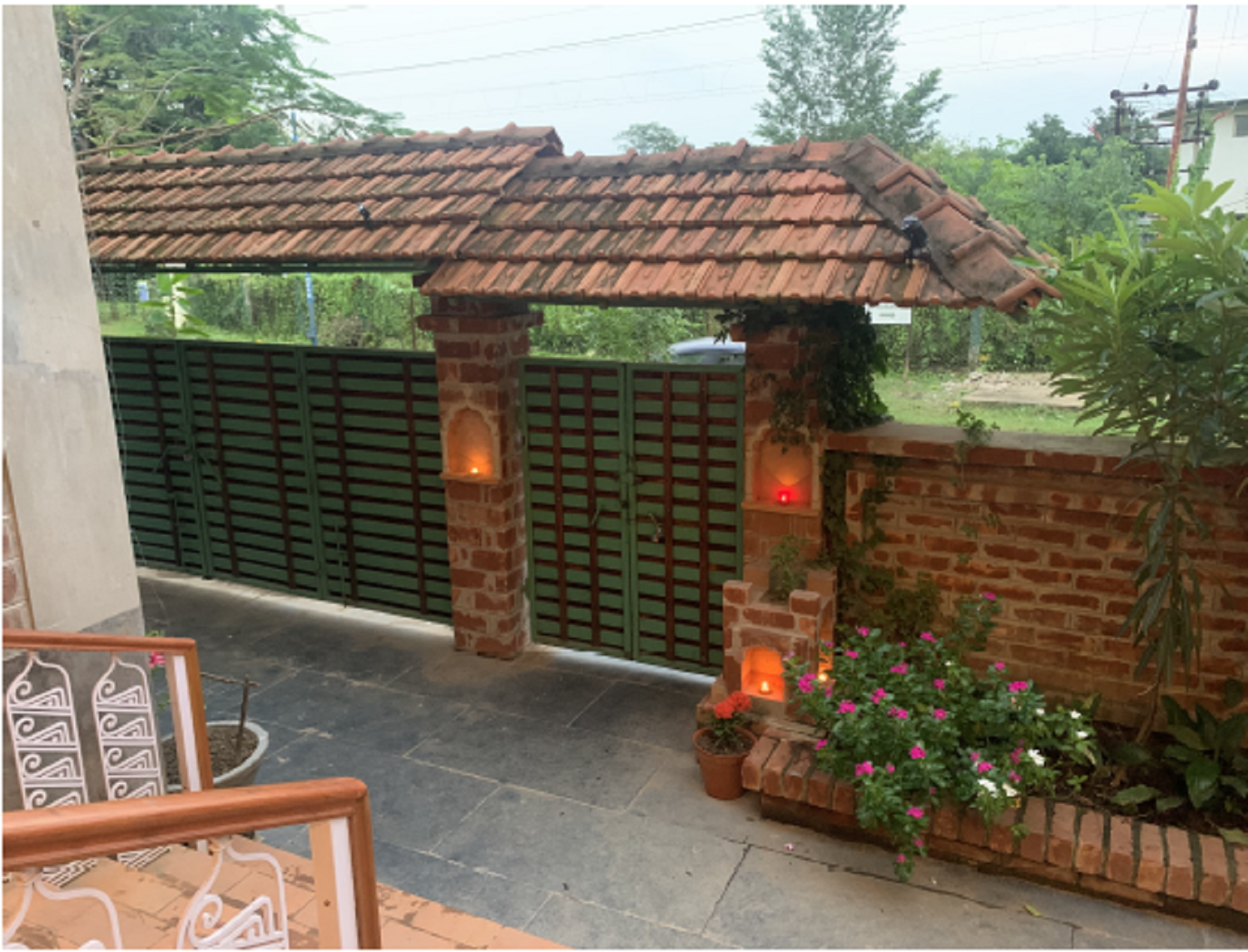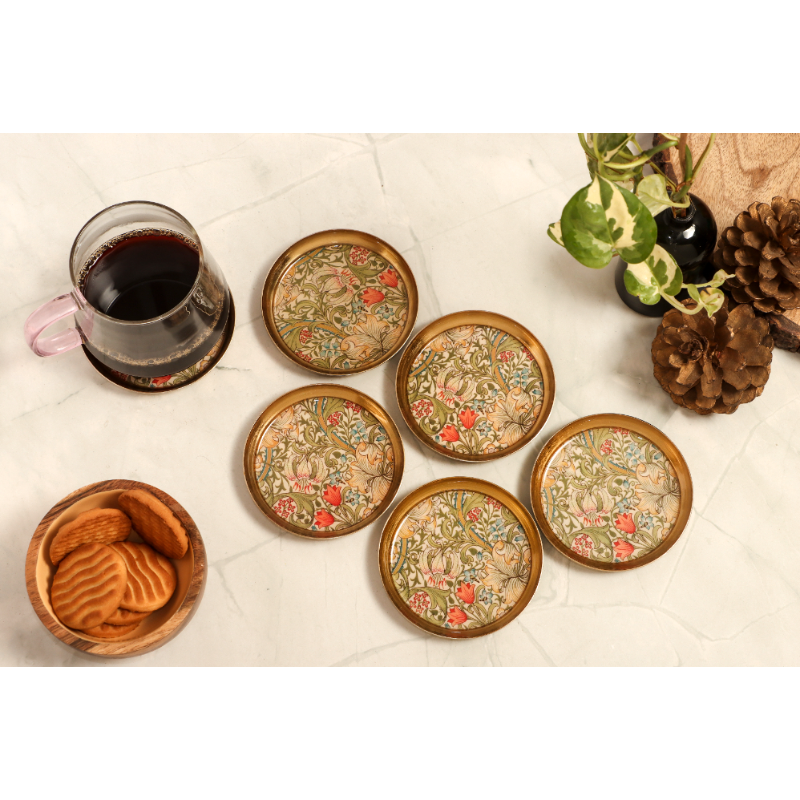Srirangam Homestay, Shantiniketan, West Bengal
Located within the buffer zone of a UNESCO world heritage site, Srirangam is the homage to the unique historical and geo-cultural centre of humanism, global learning, and the cultivation of arts – the Vishwabharati University – that was founded by Asia’s first Nobel Laurate, Rabindranath Tagore, around the turn of the 20th century, in Shantiniketan.

Srirangam has been created by Shumon Sengupta is an international humanitarian and development practitioner, working overseas for the last eighteen years. He has served in West and East Africa, South Aisa and South-East Asia. Ananya Banerjee Sengupta is a self-taught artist (water-colourist), and their daughter Madhura Sen is currently pursuing her undergraduate degree in the UK.
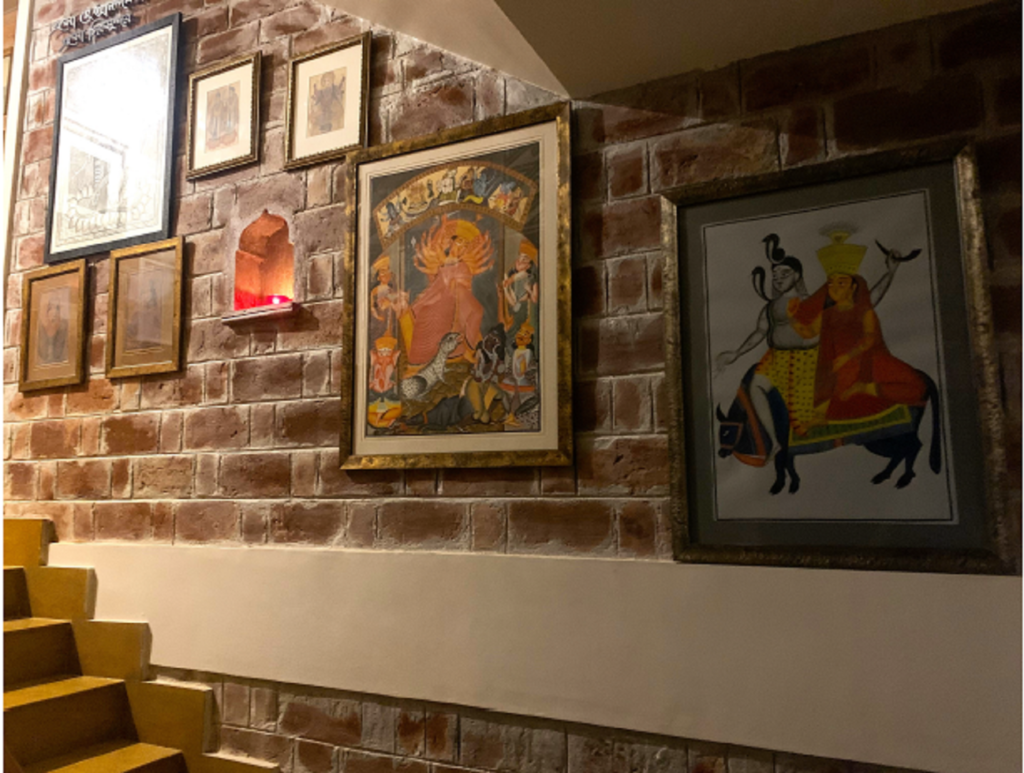
Shumon’s paternal grandparents (Niharkana and Shailendu Sengupta) had settled in Shantiniketan in the early 50’s, during the post-partition period, after moving over from Dhaka, Bangladesh. They were life-members of Vishwabharati, and Niharkana was a close associate of Indira Devi Chaudhurani (Tagore’s niece), actively involved with the Alapini Mahila Samity and the Karu Sangha.

Avid art, culture and travel enthusiasts, the couple loves meeting and knowing people with different worldviews, from all walks of life. Fun-loving, easy-going family; they enjoy lively conversations, and respect and celebrate differences and disagreement. They love being with people, as much as we cherish our moments of solitude and silence.
Rooms:
Srirangam offers five well-appointed ensuite bedrooms – Aadi, Ananta, Adwaita, Anagha and Arna – located on the first and mezzanine floors. The sixth bedroom – Aananda (on the ground floor) is set aside for the host family, but may be let out under exceptional circumstances- particularly to elderly guests, and to guests with mobility constraints.

Adwaita has a twin bed; rest of the rooms have king size beds. The size of four bedrooms is approximately 10 / 13 feet, and Anagha and Arna (which are at the mezzanine level) are 12 / 14 feet each. Each room has a reading table, a wardrobe, and a bay window, apart from curated artworks.
Aadi looks over the little water body and amphitheatre from the first floor, at the rear, whereas Ananta has access to the front balcony with uninterrupted views into the Vishwabharati grounds. Adwaita has a long bay window overlooking the wooded Srajani Shilpagram complex. Anagha and Arna are the larger bedrooms at the two mezzanine levels, above the garage, facing the main street, and overlooking the vast expanse across the street, into the sprawling Vishwabharati grounds.

Bottles with RO drinking water, and glasses are provided in each room. There is a RO drinking water unit on the first-floor common living space, and cold drinking water is available in the fridge.
Ensuite bathrooms at Srirangam are compact, but at the same time convenient, sleek, and modern – with Jaquar fittings. Shower cubicles have rain showers; telephone showers have been omitted. WCs are fitted with bidet / hygiene showers. Bathroom amenities provided at Srirangam are certified organic products, and we aspire to follow a minimal plastic waste policy, as articulated in our house rules and guidelines section.
Easy to wash and dry, flat-weave (Indian handloom) bath and hand towels are provided in bathrooms.
There is a common living cum dining area on the first floor, for homestay guests. Apart from a 10-seater dining table, there are two comfortable lounging zones in this space.
Surveillance: While we do respect and are committed to upholding the privacy of our houseguests, common areas (living cum dining area, the café downstairs, verandas, and the garden) are under 24/7 surveillance.
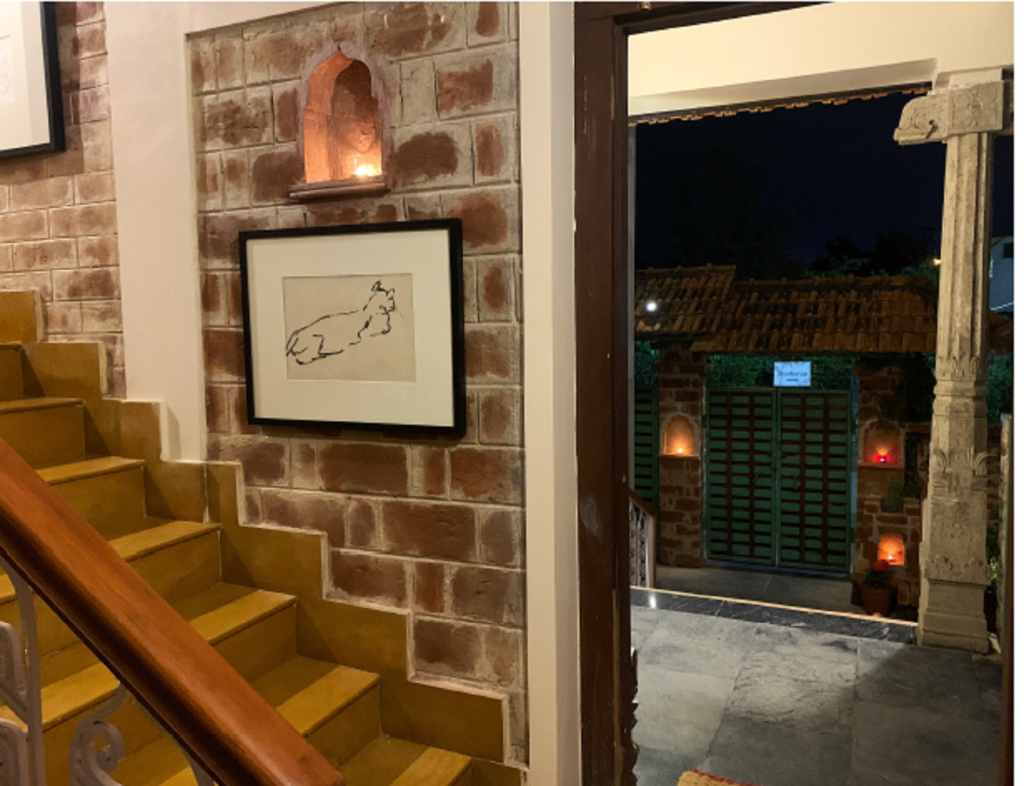
Meals, snacks, tea and coffee:
Breakfast – Indian and English (included in the room tariff for two) is served at the dining space on the first floor between 8 to 10.30 am. Guests are requested to indicate their preferred time for breakfast to the homestay manager, the previous evening.
A tea and coffee counter (with a selection of teas and instant coffee, along with condiments and disposable bio-degradable spoons) is available in the common living area of the first floor. Houseguests may help themselves to tea and coffee at this self-help counter.
Our houseguests have the option of pre-ordering their meals (lunch and dinner) and
snacks with our homestay manager one day in advance. Meals and snacks will be served at the common dining room on the 1st floor, from the kitchen at the rooftop.
Furthermore, Shantiniketan has a range of excellent eateries and cafes, particularly for lunch and snacks, for our guests to explore. We will be happy to provide a list of our favourite eateries.
The Srirangam experience:
Srirangam is a mid-size villa style homestay (primarily built as a private residence), that bears a distinctive south Indian influence. At the same time, the imprint of Rabindranath Tagore is unmissable.
Srirangam’s offer is not of opulence and luxury. We aspire to minimize our carbon footprint; the experience we provide therefore is about mindfulness; of moderation; and of being ecologically sensitive and responsive, while ensuring comfort, convenience, coziness, and conviviality.
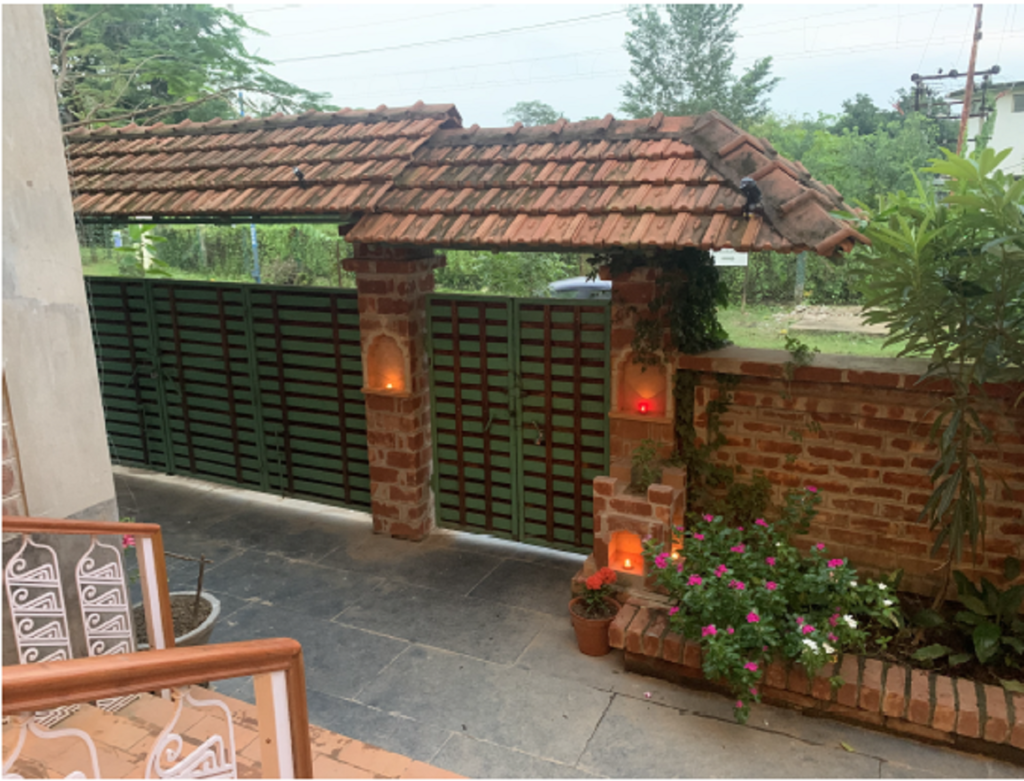
Our commitment to authenticity and excellence we believe will make every moment of your stay comfortable, enriching, fulfilling, and above all, joyful. It will help you unwind, appreciate beauty and nature, and nourish your body and soul, while providing you opportunities to explore Shantiniketan and its surrounding areas, and meet new people, if you so wish.
Srirangam is installed with Fenesta windows that provide for 80% sound insulation from outside noise. Once inside, you are therefore assured of quietude. The in-door flooring is of the traditional Athangudi-technique hand-made cement tiles (by Bharat Flooring, Mumbai), and it is best experienced barefoot.
Free, unlimited broadband internet connection is available. Password is provided during checking.
Srinidhi Art Gallery: The 1,400 square feet basement of Srirangam is well lit and ventilated and is air-conditioned in summer. The upper part of the basement being four feet above ground allows natural light to beam in throughout the day. This basement houses the Srinidhi Art Gallery, which is also used for cultural events that guests are welcome to attend.
The Gallery is made periodically available, free of cost, to young aspiring artists (below the age of 35 years) of Shantiniketan, as a part of Srirangam’s contribution to the community. Interested artists may contact the Sunlit Veranda management team regarding this.
Local tours and experiences: At Srirangam, we will be happy to suggest and organize tours to local areas of interest. To this effect, we have curated a set of experiences that we can offer, in addition to arranging for visits to other places you may want to go to.
Srirangam Homestay Pricing Policy:
Aadi, Ananta, Anagha and Aaditya are priced at INR 5,000 / night, Adwaita, which has a twin bed is priced at INR 4,500 / night. irrespective of the time of the year. Aananda, the family bedroom on the ground floor may be let out on an exceptional basis (on request) for elderly guests or other guests who may have a mobility issue. This room has been priced at INR 5,500 / night.
Room tariffs are inclusive of breakfast for two guests.Rooms are allotted based on choice of the guest and availability, at the time of booking. Annual cost escalation is applicable based on inflation and other cost of living indices.
Triple occupancy option is available in two rooms (Anagha and Aaditya) on an additional payment of INR 1,200, and this includes breakfast for the third occupant.
Rooms are allotted based on choice of the guest and availability, at the time of booking. Annual cost escalation is applicable based on inflation and other cost of living indices.
Triple occupancy option is available in two rooms (Anagh and Achyuta) on an additional payment of INR 1,500 (which includes breakfast) for the third occupant.
At Srirangam, we are committed to ethical and responsible business practice. Hence, transparency, accountability and fair pricing are integral aspects of our business ethos. We aspire to offer maximum value for money and greatly appreciate honest feedback from our houseguests so that we can be held up to the ethical business standards we have committed ourselves to.
Reaching Shantiniketan
By Indian Rail:
Bolpur is the nearest railway station (circa 4.5 km from Srirangam) with regular train connections from Howrah and Sealdah railway stations almost every hour. Vande Bharat, Ganadevata, Shatabdi and Santiniketan Express are among the most convenient trains.
Prantik station has select express and passenger trains halting.
By Road:
Circa 165 km by road from Kolkata, it takes a little over 4 hours to get to Shantiniketan.
By Air:
Nearest Airport is the Kazi Nazrul Islam Airport at Durgapur, circa 70 km from Srirangam. This airport has direct flights from Delhi, Mumbai, Bangalore, Hyderabad, Pune and Chennai. The Netaji Subhash Chandra Bose International Airport (Kolkata) connects to most national and several international destinations. Transfer to Santiniketan is by rail or by road.
Location of Srirangam, and how to get there:
Srirangam is located along the Sriniketan – Shantiniketan road, adjoining Srajani Shilpagram (Eastern Zonal Cultural Center). It is less than two kilometres from the core Shantiniketan UNESCO World Heritage Somplex. The popular Sonajhuri Haat (weekend handicrafts fair) is about 5 kms away.
From Bolpur railway station, the shortest route is head towards Sriniketan via the Bolpur – Sriniketan road and take the right-hand turn from Kalisayar on to the Sriniketan – Shantiniketan road. As you take this road, you will find a wholesale vegetable market (mandi) to your right, followed by the Srajani Sippagram terracotta toran (gate) to your left. Srirangam is the third house to your left, after you cross the Srajani gate.
Given our premium location, Srirangam is easy to get to from anywhere. In fact, it couldn’t be easier.
About Srirangam, its design architecture and aesthetic influences:
Srirangam is a mid-size villa style homestay (primarily built as a private residence), that bears a distinctive south Indian influence, where Shumon grew up, and subsequently Madhura, the daughter who went to school to (Rishi Valley).
The unique architectural style of the property, courtesy Architect Gopa Sen of Kolkata (one of the lead architects involved with the Srirampur heritage restoration), has been translated into practice by builder Sabyasachi Roy, of Surul, Shantiniketan.
The exposed brick architecture (with ‘rattrap’ modular masonry bond) of Srirangam is inspired by the works of Laurie Baker who had pioneered a unique approach to sustainable architecture in India.
The interiors have been designed and executed by Shumon Sengupta, during occasional leave from his overseas assignment.
As you enter the property, you meet the hand-carved ‘Aananda Narthana Ganapathy’ (Lord Ganesha dancing in bliss) in black stone, reminiscent of the threshold of traditional south Indian homes. The Narthana Ganapathy is symbolic of aananda, the bliss and joy we hope you will experience during your stay at Srirangam.
The two verandas in the front, lined by hand carved stone pillars, sourced from Tamil Nadu, are inspired by the colonnaded corridors of the fabled medieval temples of this state.
The little waterbody (lily pool)at the rear is reminiscent of the pushkarani or holy water tank found in the precincts of south Indian temples. The U-shaped Amphitheatre surrounding the lily pool is inspired by the step well of India, and the pitched terracotta tiled roofs hint of the Nalakettu / Tharavadu architecture of Kerala. The hand-made cement tiles on the floors (by Bharat Flooring, Mumbai, using the traditional Athangudi technique), are reminiscent of the splendid Chettinad mansions.
As you enter the main living area of the ground floor your eyes are immediately drawn to a large resplendent acrylic painting of a Kathakali actor in the role of Sri Krishna (by artist Aarohi Singh), emerging from darkness into the golden glow created by oil lamps. This is a reminiscent of the nightlong Kathakali performances (rendered exclusively in the light of oil lamps) in the temple courtyards that Shumon had witnessed growing up in Kerala.
Interestingly, the melody of our tag line আনন্দলোকে মঙ্গলালোকে-a beautiful song composed by Rabindranath Tagore – was inspired by the then Mysore State’s Anthem (titled, Kayou Shri Gowri; Kannada: ಕಾಯೌಶ್ರೀಗೌರಿ). The Mysore anthem (https://www.youtube.com/watch?v=2BGd8BE7t1E) was composed by court poet of Mysuru Shri Basavappa Shastryunder the rule of the Wadiyar dynasty in 1831 and was rendered when Tagore visited Bengaluru in 1919.
Srirangam’s relationship with South India is therefore as deliberate, as it is serendipitous.
The iron handrails, with its alpana paisley pattern provide the distinctive Shantiniketan (Kala Bhavan) touch that binds various elements together into a harmonious visual narrative, thereby maintaining a sense of underlying aesthetic integrity. Selected lines from some of Tagore’s songs are rendered on some of the walls (in floating wrought iron Bengali lettering), with the idea of giving our guest an opportunity to pause and reflect on the deeper meaning of these lines.
Srirangam is essentially a nod to the eclectic and at the same time harmonious architectural style that was developed in Shantiniketan (primarily by Surendranath Kar, under Tagore’s guidance) during its early years.
We have reasons to believe Tagore would have approved of Srirangam, and we hope you, our honoured guest, will concur.

